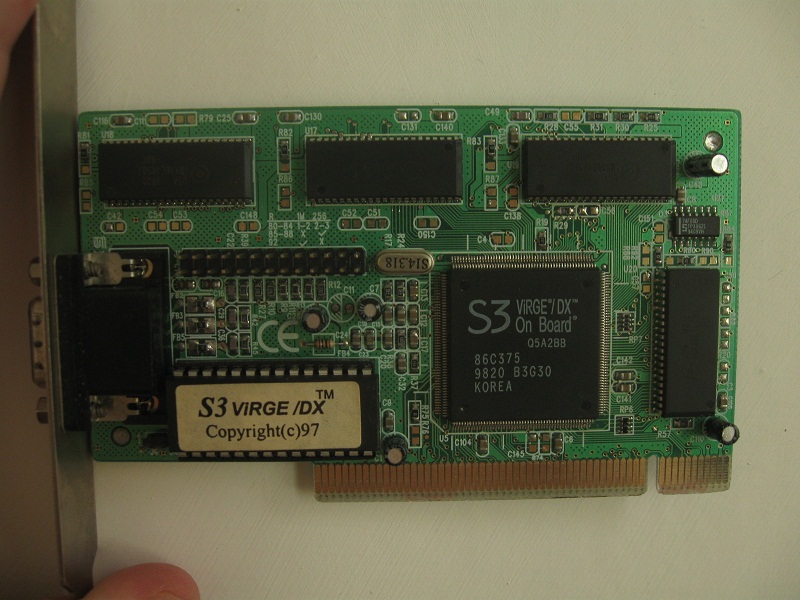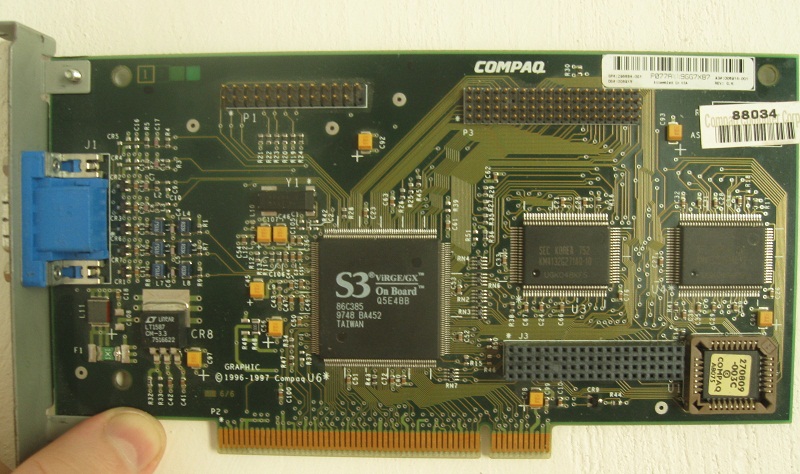Doing more per cycle
One year after the first Virge generation S3 unleashed new one and again in two flavors. The cheap DX chip and just one dollar more costly GX. The only difference is that GX support synchronous memory. This time no extra jewelry, both are limited to 4 MB and carry 170 MHz RAMDAC. Updates done to the 3D engine are significant. Perspective correction is separated and does not eat clocks of the whole pipeline, which now needs in best case only two clocks to process bilineary filtered textured pixel. What more S3 implemented texture filter able to sample from different mip-map.
ViRGE DX

I happened to get several different DX cards and decided to use this little puppy for tests, as it is an average overclocker among those with 4 MB of EDO memory. It peaks at 64 MHz despite having only 60ns memory. Brand is unknown to me, it looks cheap and indeed default clock is anemic 45 MHz. This is quite common for 4 MB boards, those with 2 MB tend to be clocked at 55 MHz or even higher. As I cannot be bothered to test both memory variants I set this one to classic 55 MHz, which will serve well for clock per clock analysis.
Lets compare this DX with original Virge, both with with 4 MB EDO RAM and same clocks.

That is average 40% percent advantage of DX, very nice reaction to 50% theoretical increase of fillrate. In the best case of Mechwarrior 2 Titanium drivers can very well be responsible, as first Virge have broken dynamic lightning beside usual problems. Or it is really more enhancements kicking in, there are several games going more than 50% faster with the exactly same memory bandwidth. S3 claimed up to three times performance increase with DX/GX after all.
ViRGE GX

Represented by a Compaq card, memory expansion module stripped off. The only difference from DX is higher memory clock of 75 MHz, therefore memory bandwidth increased by more than one third of EDO cards to solid 600 MB/s. This board enjoys SGRAM memory as most of GX did, however it was still possible to use cheaper EDO or SDRAM of same frequency. Again the same question as with VX arise- is the GX chip able to put the bandwidth into good use?
 A bit dejavu, 9% FPS gain. While the GX reliably outperforms DX, the difference is probably smaller then in pricing back in 1997.
A bit dejavu, 9% FPS gain. While the GX reliably outperforms DX, the difference is probably smaller then in pricing back in 1997.
 Minimal FPS again reacts more sensitively, 19% average gain. In light of those numbers second generation of Virge looks rather well balanced in terms of chip / bandwidth ratio. But the DX is certainly more starved than original Virge.
Minimal FPS again reacts more sensitively, 19% average gain. In light of those numbers second generation of Virge looks rather well balanced in terms of chip / bandwidth ratio. But the DX is certainly more starved than original Virge.
Experience
 Demonstration of heavy dithering artifacts of transparent textures at 16 bit depth.
Click on the image to see the proper blending at 24 bit mode.
Demonstration of heavy dithering artifacts of transparent textures at 16 bit depth.
Click on the image to see the proper blending at 24 bit mode.Unless 8888 RGBA texture is used, and that was rare sight back in the days, the Virge has to manage with 4 bits of alpha precision. Sometimes blending artifacts get so bad one could think there is some cheap stipple alpha at work. The blending of Virge is far from that though, as true color mode proves. Artifacts of the 16 bit dithering are multiplied by number of surfaces drawn over. Every 3d frame drawn in 16 bits has a dither pattern with interleaving darker and brighter pixels. Alpha texture on top of that adds a bit of brightness and when brighter pixels meets they are multiplied and can become almost white. When bad enough situation occurs the pattern may appear stipple-like.
Both cards are using Virge "fast" driver, which S3 still provides on their web. The name is deserved, it really helps with Direct3D performance. Good news with DX and GX is some problems with mip-mapping are gone, well except MechWarrior. While one more blending mode was added, most of the newer games are still having problems and dithering artifacts persist in 16-bit colors. 24 bit rendering can still save the day though. Opposed to first Virge more games are renderer correctly, i.e. Flight Simulator 98 or Quake, some are significantly improved like Forsaken. Monster Truck Madness 2 is doing well at least from cockpit view. Even Viper Racing looks fine, if only Virge was not so skimpy with smoke. The last problem in TNP is a flamethrower. Turok has still the same serious issues. Most of textures in F22 TAW are still missing, Half Life or Thief still completely gives up on texturing. CART got even worse with annoying lines rendered across the track.
 As time went by blending modes became the biggest pain of Virge, check the gallery
As time went by blending modes became the biggest pain of Virge, check the gallery
Conclusion
Overall performance and whole experience are better. The holy grail of gaming at 640x480 is still unreachable, however early games are easily playable at 400x300. While performance improvement over first Virge architecture is significant 50%, it was not enough to catch up with the rest of the industry. But pricing considered it did not have to, these cards would be good deal if drivers were up to date. But then there still remained incomplete feature set, which was in my opinion crucial. As 3d acceleration matured prevailing absence of additive and multiplicative alpha blending could no longer be tolerated. And S3 was not yet done with Virge architecture, not by a long shot.
continue to Virge /MX and /GX2 review